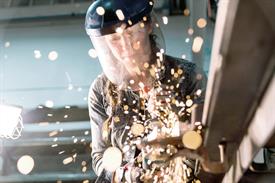
Even during these challenging times, the demand for workers in the skilled trades remains high, with projections from the U.S. Department of Labor forecasting 8 to 9 percent growth over the next decade. Schoolcraft College stands ready to meet that demand with the all-new Manufacturing & Engineering Center (MEC), which is set to open later this year.
Several programs currently housed in the Applied Science building will be moving to this 48,000-sq. ft. facility, including welding. April, in fact, is recognized as National Welding Month by the American Welding Society®.
Here are some facts from the AWS:
- Welding is the joining of two or more materials through heat or heat and pressure, forming a bond between two pieces of metal or plastic.
- Welding is used to build ships, automobiles, planes and space vehicles.
- Advancements in materials, processes and equipment make modern welding an increasingly high-tech skill.
Schoolcraft College’s Welding Technology program is aligned to AWS industry standards and offers three welding program options to allow students to customize their career pathway. The options are:
Pre-Apprenticeship Certificate
- First step in becoming a welding Journeyman.
- 27 credit hours (can vary).
- Students completing the coursework successfully will also earn American Welding Society certification in at least one welding procedure.
Fabrication
- Certificate.
- 33 credit hours.
- Prepares students for jobs involving metal inert gas and tungsten inert gas welding.
- Also provides knowledge of plasma, arc and oxy-gas cutting technologies.
Joining Technology
- Associate of Applied Science Degree.
- 64-67 credit hours.
- Prepares students for jobs in industrial, prototype and machine-tool building, heavy equipment, construction and emerging green and sustainable technologies.
The welding pre-apprenticeship certificate, through a partnership with local trade unions, helps ensure that students have the skills, knowledge and training necessary to be safe on the jobsite, competitive in the workplace and satisfied in their careers.
All programs emphasize both hands-on welding skills and knowledge of metallurgy and other materials to prepare students with the in-demand skills needed. Schoolcraft College also offers a direct line to the Iron Worker Apprenticeship program.
“We are the only program that I know in Michigan that requires our students to become certified welders,” said Coley McLean, welding instructor. “We focus on muscle memory and science. We expect our students to know how to read and write a Welding Procedure Specification along with the selection of filler materials and shielding gas properties.
“We don’t want our students to just be welders, we want them to be smart welders.”
A key advantage for the program is that Schoolcraft College is an Accredited Test Facility (ATF) for the American Welding Society. Schoolcraft College’s ATF is accredited to conduct welder qualification tests for the AWS Certified Welder credential. Welders who possess the AWS Certified Welder credential are in very high demand to replace workers who are retiring.
Further, the program at Schoolcraft College is unique in that each student must earn at least two AWS certifications in order to successfully complete all programs. The program has certified over 300 students and over 200 individuals from industry.
Also, the experts at Schoolcraft College have qualified and written several welding procedures for a wide variety of industries.
“For our instructional staff, we employ only certified welders who have over five years of experience in the field,” McLean said. “This means our instructors come from industry and are extremely qualified individuals. Our instructors include welders from aerospace, construction, journeyman and business owners.”
Finally, the Welding Technology has engaged with students despite closing the actual labs.
“We are teaching six classes remotely, and when I say remotely, we are not just putting tests online – we are engaging students,” McLean said. “We loaned out our own welding equipment so the students who intended to graduate will still have the opportunity to do so from home.”
When Welding Technology moves to the MEC
- More workstations – from 17 to 34.
- Bigger, too – 25% larger.
- Fabrication lab doubles in size.
- Dedicated lecture classrooms and a computer lab.
- Just for welding students, making scheduling easier.
- More types of labs – destructive and non-destructive.
View more information on Schoolcraft College’s Welding Technology program.